Shiro Kasamatsu - A Glimpse at the Blocks
(June 2003 -- Kyoto, Japan)
|
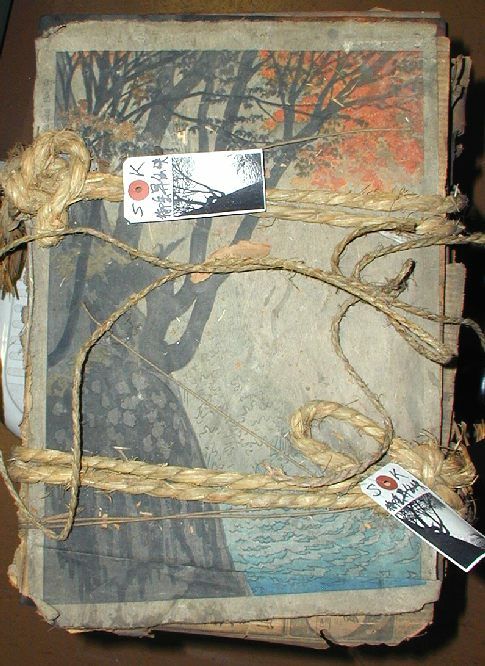
|
During a recent visit to the Unsodo Publishing House in Kyoto, Mr.
Yamada, the President and owner gave me unexpectedly the opportunity
to study some woodblocks of Shiro Kasamatsu. And here, I do not refer to
his prints--instead, I'm now talking about the actual carved woodblocks.
Left: Shiro Kasamatsu's print, "Mitake Shosen Kyo," (1954), wrapped on top
of the corresponding set of woodblocks.
|
Following a cordial greeting, I was then guided by Mr. Yamada into Unsodo's fire-safe storage area, known as a kura. There, on tall staircases of this storage room, where apart from
many books and paper supplies stored on several steel shelves, were stored many sets of woodblocks for the prints by Kasamatsu, Okada
and likely additional artists. Here then, these valuable woodblocks were kept under the appropriate steady climatic conditions; as
changes of temperature and humidity are the worst enemies of woodblocks, causing warping
and cracking.
|

|

|
|
Left: Kasamatsu's "Nikko Jinbashi" (upper), "Rice Planting" (lower)
Right: Various prints by Okada.
|
Kasamatsu's most famous design: "Nikko Kegon Falls," with its full set of
five cherrywood blocks.
|
As we can see, during storage each carved face is separated by several layers of newsprint to prevent scratches
and damage, with the set of blocks is tied together with a cord. Some of the apparent aging of these
old cords tells us how long already the blocks have been stored tied together. On
top of each stack is one original print, sometimes two or three for immediate
identification and probably an aid for the printer to correctly match the colors for the later
reprints. For me, as a collector I somehow feel pain, seeing such excellent prints
abused as merely "wrapping paper."
|

|

|
|
Okada's "Fuji" - Perfectly wrapped.
|
Kasamatsu's - "Ikebana"
|
|
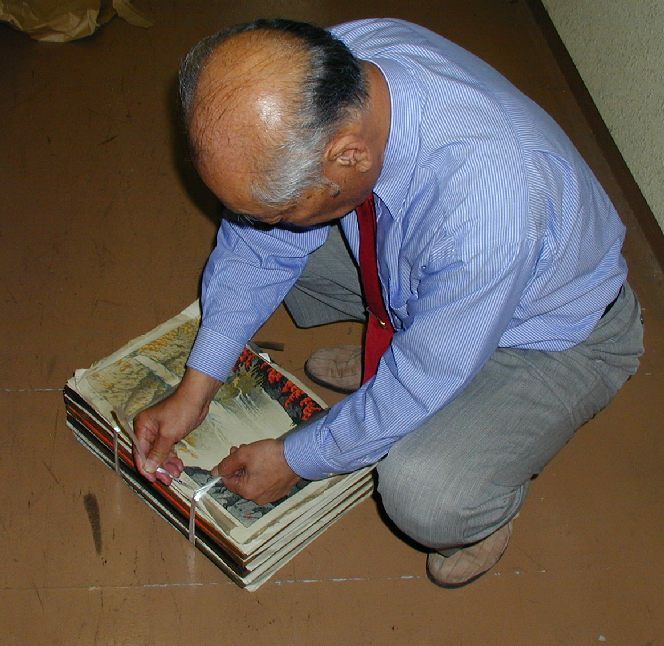
|
Left: Mr. Yamada is seen opening the bundle of the "Kegon Falls" blocks.
This set is comprised of only five wooden blocks, however, four of
them are carved on BOTH sides, so that together with the keyblock
in total nine blocks are sufficient to print the famous
view of the "Nikko Kegon Falls."
Additionally, several of these blocks allow the simultaneous use of two different colors,
providing that these areas are sufficiently separated from each other
to prevent smudging. On each of the blocks we recognize in the
lower left corner the L-shaped "kento mark" (kagi) and in the
upper left side the straight shaped "kento mark" (hikitsuge). Both of these alignment
marks are essential for the so-called "registration" of the blocks,
or, simplier said, to align the paper correctly on each block.
Remaining printing ink in the kagi and next to the hikitsuge
are responsible for the "dirty triangle" on the right
lower corner of many prints and for the mark on the right upper
side - indicating that the print is indeed handmade. Often, in case
of paper with an uneven, natural edge, a small straight edge of paper
is cut off to enable alignment in the kagi.
The printing work itself is a very fast process, as the printer is paid for the
finished print according to the number printed, therefore, no time for unnecessary
cleaning is wasted, According to the literature, a skilled printer
needs only approximately 30 seconds time to pull a "key-block" and one
minute for a color block.
|
The Blocks:
|
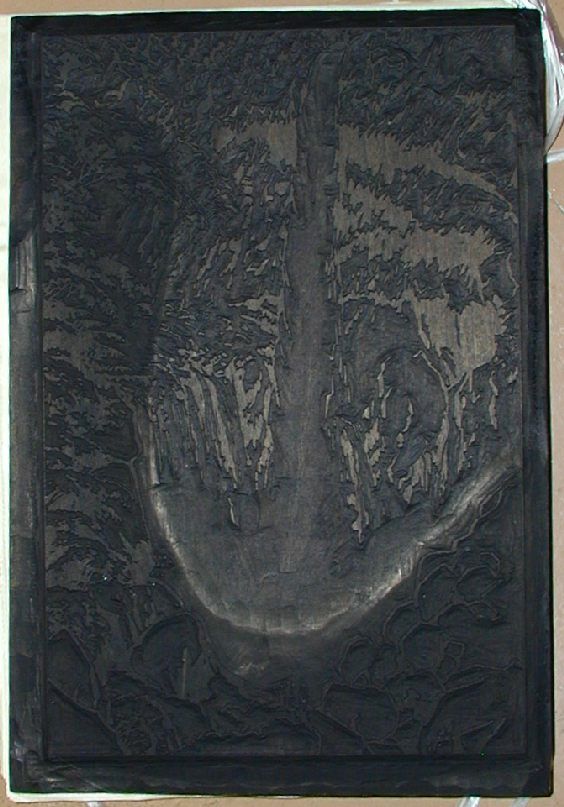
|
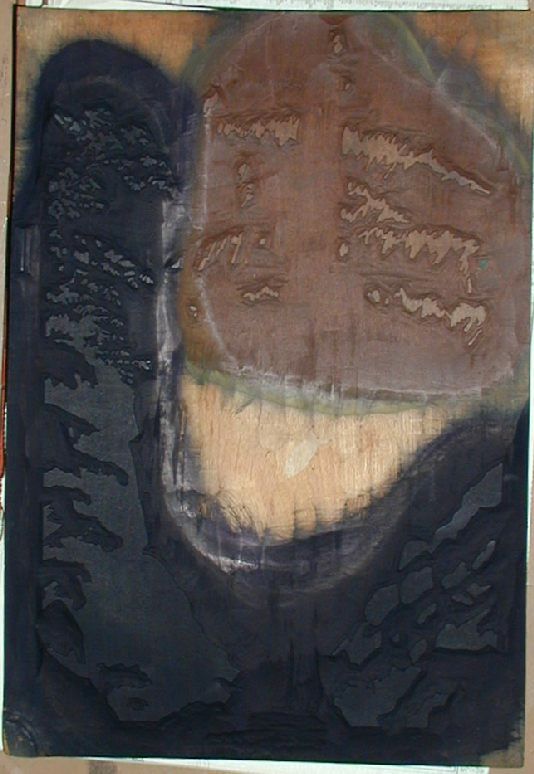
|
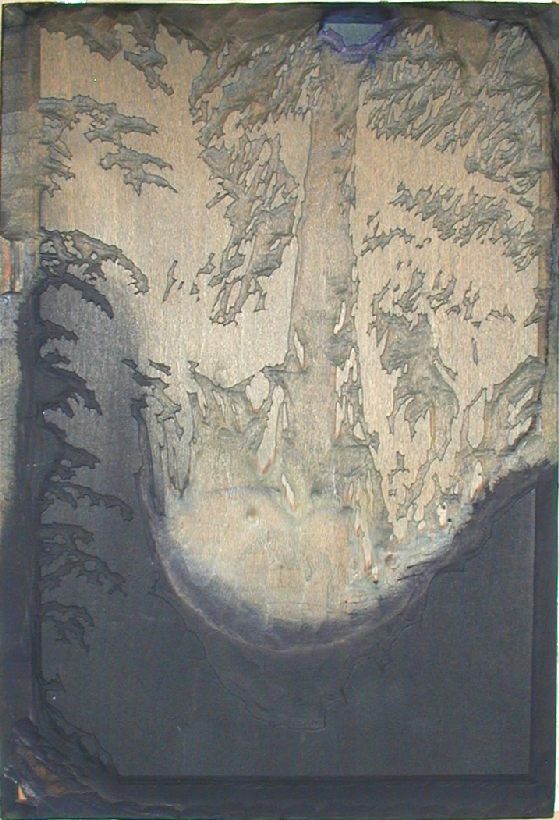
|
|
Block 1: The black-inked "key-block."
|
Block 2: Grey and brown.
|
Block 3: Grey and blue.
|
|
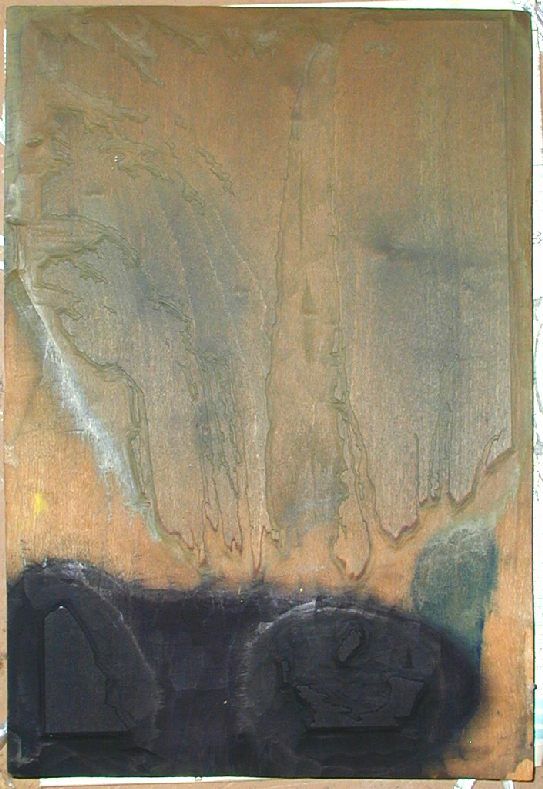
|
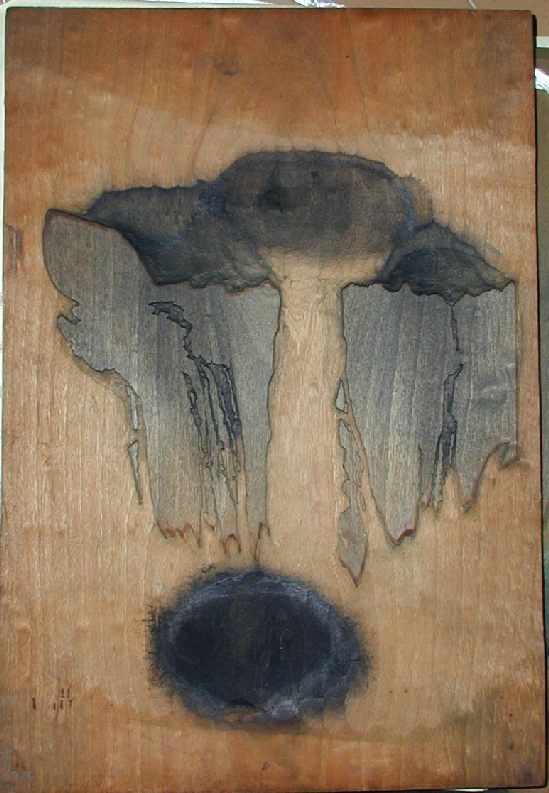
|

|
|
Block 4: Grey and light grey.
|
Block 5: Again, several shades of grey.
|
Block 6: Blue
|
|

|

|

|
|
Block 7: Ochre and black.
|
Block 8: Shades of orange.
|
Block 9: Red and blue.
|
Note, on the blocks 8 and 9 we can clearly still see where some paper is left. In the process of making
of a print first the "key-block" (No. 1) is carved. Then, several prints on very
thin paper are pulled (printed) from this "key-block," showing only the print's black contours, and
subsequently glued face down on further blocks, one for each color. Next, the
artist or the printer "paints" on each block, or better, the paper
on its face, the color, which are the parts to remain (uncarved) on the block. In the final
step the carver removes all unnecessary material on the block. (To learn more about the "printing process," see our article article titled "Hanshita," or Black Ink "Key-block" Outlines.")
|
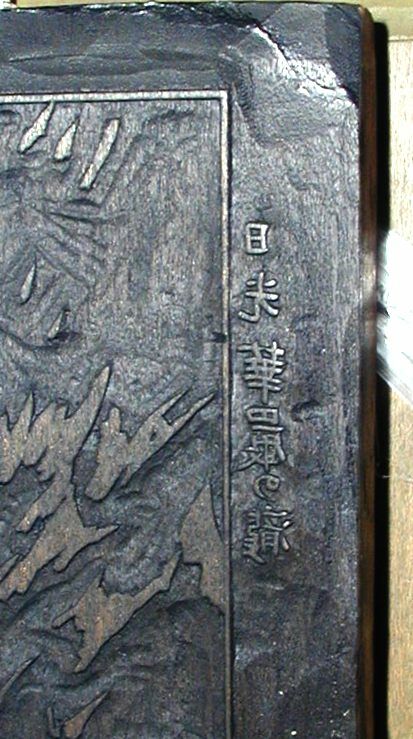
|

|
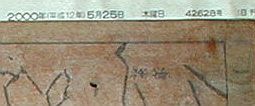
|
|
The title, in Japanese "kanji."
|
The margin: Where are the seals?
|
The newsprint's date: May 25, 2000.
|
The newspaper which was used to wrap the blocks is dated May 25, 2002,
thus indicating that the last run of reprints, done by Unsodo's contract printer
Toda, was just before this date.
Surprisingly however, the "right" margin of the keyblock - which later
becomes the left margin of the paper - does not show any seals!! I expected there to find
at least the Unsodo Han "publisher's seal" and the Shinmi/Nagashima
"printer/carver seals." I always thought (and this was an understanding I got
from Unsodo) that such essential information was a part of the "keyblock," or at
least inserted as a "koma", a kind of insert into the "keyblock." Now
I learned that these data are printed separately onto the print - so it seems, we never stop
to learn appearently! A study of further sets of blocks further confirmed this - no
seals on the "keyblocks."
Closing thoughts:
In the end then, "How to end such a day after visiting Unsodo in Kyoto....??"
Simple. I visited the dance festival "Kamogawa Odori," strolled along the famous
river banks of the Kamo River, enjoyed together with
Japanese friends food and beer, and then finally went back to my home in Tokyo that same evening
- the Nozomi Shinkansen Train taking only 2:16 for the 300 miles!!
(I want to express my deepest thanks to Mr. Yamada of Unsodo for allowing me the opportunity to study
their many woodblocks.)
(c) Andreas Grund and Thomas Crossland -- June 2003
Gallery
Terms
Ordering
About Us
We Buy Prints
Library

















